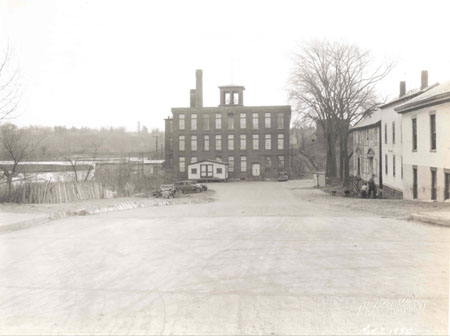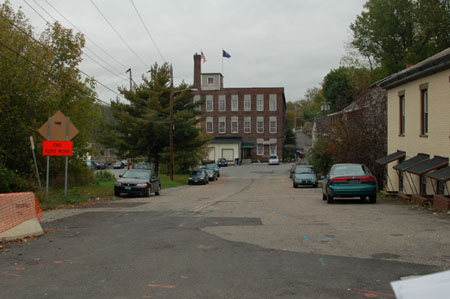

 |
 |
27. MILL STREET FROM COLCHESTER AVENUE November 1, 1935 This image shows the length of Mill Street from Colchester Avenue, looking east to its end at the mill, owned at the time the photograph was taken by the American Woolen Company. The streetscape is quite bleak. Aside from two men who appear to be passersby entering an alley between two of the tenement buildings, there is no activity going on here. The Winooski River at the Upper Falls is visible on the left side of the image. There is a ramshackle stockade fence along part of the riverbank. Two or three automobiles are parked near the mill building. Three tenement houses, at 495 Colchester Avenue, 5-7 Mill Street and 13-19 Mill Street are closely aligned on the right. The brick masonry building at 495 Colchester Avenue (photographed from the front in image 26) is partially visible in the foreground. Both 5-7 and 13-19 Mill Street are two-story, multiple-bayed wood structures. The American Woolen Company’s mill is nine bays wide and three stories high. A ground level wood door is located in the third bay on the left. A small wood outbuilding that appears to be a storage shed blocks a full view of the mill’s façade. The fenestration consists of large windows with granite sills: nine-over-nine sashes below with six paned transom lights above, to allow as much natural light as possible into the interior work area. The flat roof has an articulated cornice all around. A hip-roofed open bell tower sits atop the roof at the center of the facade . There are two tall smokestacks, and a three story ell is partially visible on the north side. The site of this mill has great historical significance for the city of Burlington. As Thomas Visser wrote in 1986 in a proposal to extend the boundaries of the Winooski Falls National Register District: " Within several years of the first permanent settlement at Winooski Falls, Ira Allen, a founder of Vermont and major land-holder in the region, constructed a dam across the Winooski (Onion) River at the upper falls and built sawmills on both ends. These provided lumber for local construction as well as for export to Lower Canada and England. Ira, with his brothers Ethan, the Revolutionary War hero, and Levi, a merchant operating from Saint John’s, Lower Canada, started the Onion River Company, with a store located at the falls, which was the head of navigation from Lake Champlain. They also had the first road… constructed to the falls, crossing there by ferry and then a bridge. Onion River Falls, as it was then known, was the major commercial center in Northern Vermont."[1] During the nineteenth century, a series of mills, first for lumber and grain and then for textiles beginning in the 1840’s, were built on both sides of the river near the falls. The mill in the McAllister image was constructed in 1892 by the Burlington Cotton Company.[2] The American Woolen Company of Fall River, Massachusetts bought the Stock of the Burlington Company for $240,000 in 1906.[3] The mill closed its doors in the late 1920’s, but opened again to produce khaki for the United States Army during World War II.[4] [1] Thomas D. Visser, “Winooski Falls Historic District, Proposed Boundary Increase, Amendment to National Register Nomination” (1986). [2] Visser, “Winooski Falls Historic District.” [3] David J. Blow, Historic Guide to Burlington Neighborhoods, Vol. 2 (Burlington: Chittenden County Historical Society, 1997), 105. [4] Ralph Nading Hill,The Winooski: Heartway of Vermont (New York: Rinehart and Company, 1949), 256. |
27. MILL STREET FROM COLCHESTER AVENUE October 11, 2005 (18T 0644200 UTM 4927721) Mill Street appears essentially the same in this recent image, but now it seems to be a more prosperous neighborhood The structures visible in the 1935 image are still standing. There are awnings on the lower story windows at 495 Colchester Avenue. Two poles atop the enclosed tower on the (now) Chase Mill building fly banner flags. Trees line the riverfront |
Colchester Avenue east of East Avenue, Barrett and Mill Streets
Historic Burlington Project Burlington 1890 | Burlington 1877 | Burlington 1869 | Burlington 1853 | Burlington 1830 Produced by University of Vermont Historic Preservation Program graduate students in HP 206 Researching Historic Structures and Sites - Prof. Thomas Visser in collaboration with UVM Landscape Change Program Historic images courtesy of Louis L. McAllister Photograph Collection University of Vermont Library Special Collections |